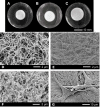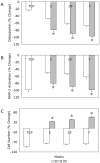The role of ERK signaling in protein hydrogel remodeling by vascular smooth muscle cells
- PMID: 17544501
- PMCID: PMC2001258
- DOI: 10.1016/j.biomaterials.2007.05.007
The role of ERK signaling in protein hydrogel remodeling by vascular smooth muscle cells
Abstract
Collagen type I and fibrin hydrogels have been used for cell-based therapies and tissue engineering. These matrices can be broken down and remodeled by cells, but the effects that these proteins have on cell function are not completely understood. We examined activation of the extracellular signal-regulated kinase (ERK) signaling pathway by vascular smooth muscle cells (VSMC) in response to 2D and 3D matrices of type I collagen, fibrin, or a 1:1 composite mixture of these proteins. After 3 days of culture, ERK phosphorylation, osteopontin secretion, and MMP-2 activation were all markedly increased in 3D matrices, compared with 2D substrates. A strong positive correlation existed between these protein markers of the synthetic phenotype and phosphorylated ERK levels, and this relationship persisted across matrix geometries and compositions. Cell proliferation in 3D matrices was inversely correlated to ERK activation, while on 2D substrates a modest positive correlation was observed. Pharmacologic inhibition of ERK signaling confirmed that this pathway was involved in the observed phenotype shifts. This study suggests that contextual activation of the ERK pathway results in different effects on cell phenotype, depending on the geometry and composition of the ECM. These findings add to our understanding of cell function and remodeling in protein-based hydrogel biomaterials.
Figures






References
-
- Badylak S, Liang A, Record R, Tullius R, Hodde J. Endothelial cell adherence to small intestinal submucosa: an acellular bioscaffold. Biomaterials. 1999;20(2324):2257–63. - PubMed
-
- Berglund JD, Mohseni MM, Nerem RM, Sambanis A. A biological hybrid model for collagen-based tissue engineered vascular constructs. Biomaterials. 2003;24(7):1241–54. - PubMed
-
- Isenberg BC, Tranquillo RT. Long-term cyclic distention enhances the mechanical properties of collagen-based media-equivalents. Ann Biomed Eng. 2003;31(8):937–49. - PubMed
-
- Yao L, Swartz DD, Gugino SF, Russell JA, Andreadis ST. Fibrin-based tissue-engineered blood vessels: differential effects of biomaterial and culture parameters on mechanical strength and vascular reactivity. Tissue Eng. 2005;11(78):991–1003. - PubMed
-
- Grassl ED, Oegema TR, Tranquillo RT. Fibrin as an alternative biopolymer to type-I collagen for the fabrication of a media equivalent. J Biomed Mater Res. 2002;60:607–12. - PubMed
Publication types
MeSH terms
Substances
Grants and funding
LinkOut - more resources
Full Text Sources
Research Materials
Miscellaneous

